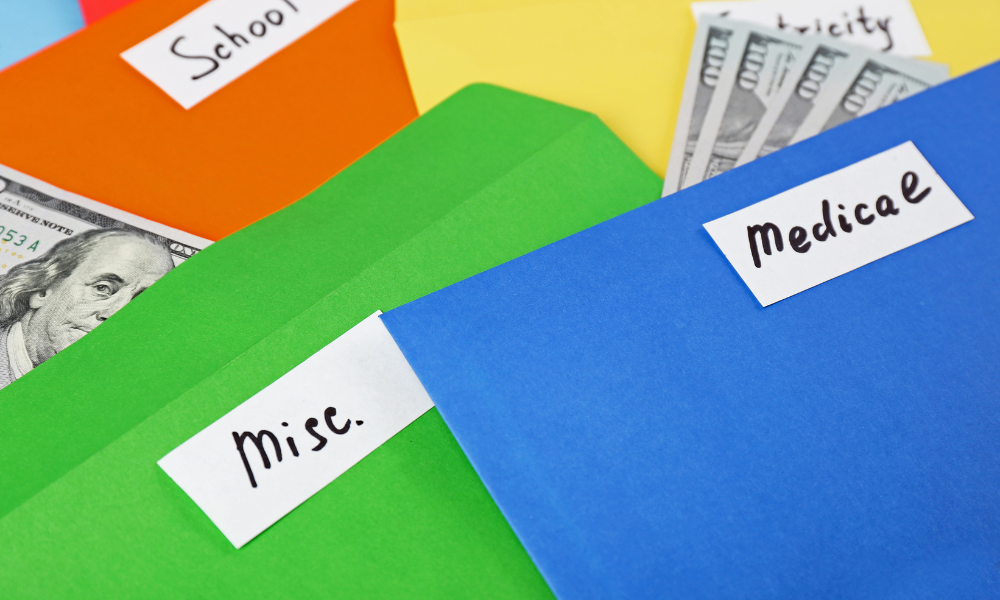When it comes to budgeting, you’ve likely already heard of the envelope system. But what is it? In this article, we will explain what the envelope system is and what its benefits are. Then will show you how to do it in five easy steps and give you some tips for successful budgeting with the envelope system.
What is The Envelope System?
The envelope system is a cash-based budgeting method. It allows you to allocate specific amounts of cash to different spending categories. Each category has an assigned envelope, providing a tangible and visual representation of your financial goals. By easily visualizing and controlling your spending, you can create better discipline and financial habits. It is a simplified way to budget that offers some excellent benefits. Here are the major benefits of the envelope system:
- Control Over Spending: The envelope system forces you to allocate a specific amount of cash for each spending category. When the cash in an envelope is gone, you can’t spend any more in that category until the next budgeting period. This strict control helps you avoid overspending and stay within your budget.
- Visual and Tangible: Unlike digital or spreadsheet-based budgeting methods, the envelope system is tangible. You can physically see how much money you have left in each envelope, making it easier to track your spending and stay accountable.
- Eliminates Debt and Promotes Saving: By restricting your spending to the cash in the envelopes, you’re less likely to rely on credit cards or loans to cover expenses. This can help you reduce debt and allocate more money toward savings and financial goals.
- Simplifies Budgeting: The envelope system simplifies the budgeting process by breaking it down into discrete categories. This makes it easier to allocate funds for essentials like groceries, bills, and entertainment, ensuring you prioritize your financial responsibilities.
- Teaches Financial Discipline: Managing physical envelopes requires discipline and self-control. It can help you create healthier financial habits and become more conscious of your spending habits. This budgeting style helps you to consider your purchases more carefully fostering a more attentive attitude to money management.
How the Create and Use The Envelope System
Creating and using the envelope system is easier than you think. Here are five steps to get you started and keep you going:
Step One – Assess Your Income and Expenses
Examining your income and spending is the first step in any budget. Start by determining your net income (the amount you make after taxes and deductions). Write down your monthly income in bold at the top of a sheet of paper. Now, look at your expenses. These should include both fixed and variable costs, such as rent and utilities. Write down each expense and the average amount you spend on it each month.
Step Two – Set Up Your Envelopes
To set up your envelopes for budgeting, you need envelopes. You can either get actual envelopes of any size or color or you can use small containers. You can even get crafty and decorate or paint your envelopes or containers. Once you have your envelopes in hand and a good place to keep them, it’s time to set them up.
Label each envelope with the category name, such as food, rent, transportation, electric bill, or entertainment. Make sure to create a savings envelope and one for an emergency fund (we will get back to that shortly). Make sure that you have enough envelopes to cover all of your budgeted areas. Consider using different colors or patterns for each envelope to make them easily distinguished.
Step Three – Allocate Your Budget to Each Envelope Category
When you’ve calculated your income and expenses and set up your envelopes (or containers), you can divide your budget into separate categories. Take all of the cash you have and allocate it into the categories that take priority (such as rent or phone bill).
Once you do this, you can see how much money you either have leftover or how much more you need to add to each envelope. If you have leftover cash, you can allocate it into your savings envelope or put it into entertainment. You can also allocate any extra funds to a category that already has the needed amount of cash. This will put you ahead for the next month.
Step Four – Spending Cash From The Envelopes
When you need to make a purchase, simply use the cash from the envelope in that category. This ensures you don’t overspend in any category. For example, if you are headed to the grocery store and need the cash for it, take it from the grocery envelope. If you don’t have enough in that envelope, you may have to borrow from another category. This is where the tangibility of the envelope system shines. By physically taking from another category, you can consciously see how much your spending (and where you spend) impacts your financial stability and goals.
A good rule of thumb is – if you don’t truly have to spend it, then don’t. Be honest with yourself. There are a lot of things you can stop spending money on right now. You want to avoid having to take from other categories all you can. If you absolutely must borrow from another envelope, first take from a category that is less-prioritized such as clothing or a bill that is due later than the others. Make sure to mark the envelope so you know how much was borrowed.
Step Five – Monitor and Adjust
Monitoring your envelopes regularly is critical to successful budgeting. Make sure to regularly check your envelopes to see how much cash remains in each category. Assess how much you need to add or how much can be moved to a more prioritized expense. This will help you constantly know where you are financially keeping you from overspending and helping you make better financial decisions.
Regular monitoring also allows you to adjust your budget as needed based on your actual spending patterns. If you consistently spend less in one category, you can reallocate that extra cash to another category or increase your savings.
Preparing for Unexpected Expenses
When it comes to dealing with unexpected expenses, it is vital to be prepared. If you don’t have money set aside for emergencies, you can easily throw your entire budget out of whack. Be sure to set aside an envelope for unexpected expenses. This emergency fund guarantees that you have a safety net to fall back on if something unexpected occurs.
That can be anything from car or home repairs to traffic tickets to cell phone damage. Allocate a small portion of your budget to this envelope and add any leftover funds when you can. Preparing for unexpected expenses when budgeting with the envelope system can be one of the most important things you do for your financial security, stability, and happiness.
Closing Thoughts
The envelope system is a simple and efficient budgeting style that can help you gain control of your money. By allocating your budget to categorized envelopes, you can track your spending and ensure that you stay within your means. With the envelope system, you have a tangible representation of your money, which can make it easier to resist impulse purchases and prioritize your financial goals. Monitor your envelopes regularly, adjust accordingly, and prepare for emergencies and you are more likely to be successful in your budgeting. So get some envelopes and get allocating!











